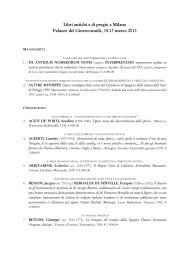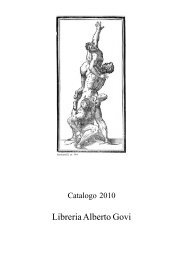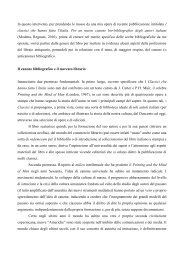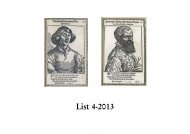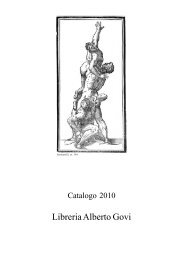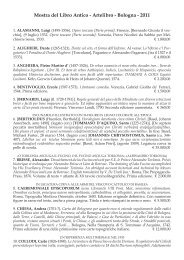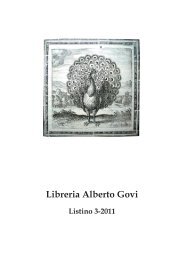ument. As early as 1543, this Giudizio of Cavalcanti evolves a fairly complete theory of the tragedy, based in largepart upon Aristotle’s Poetics but referring also to certain of Horace’s tenets and to the current rhetorical tradition. Itcalls upon the dramatic poet to observe the laws handed down by the ancients; but it also urges him to follow theexamples of such practitioners of the art as Seneca and Trissino. Especially, it recommends attention to the needsof the audience, to the fact that tragic poetry is made to be performed in public. The tragic effect must be thoughtof in terms of that audience; it must be achieved through a proper subject, involving the right kind of characters,combined in a proper plot. Lyric effects are not acceptable and hence such florid diction as Speroni’s is to be condemned.In every way, the peculiar requirements of tragic poetry must be satisfied. The Canace, because it fails tosatisfy them, is a fit target for the practical critic as well as for the theorist” (B. Weinberg, A history of literary criticismin the Italian Renaissance, Chicago, 1961, pp. 922-923). In his reply, Apologia (completed in 1554, but published onlyin 1597), Speroni maintained that his work was a true tragedy and defended his use of a mixture of seventeen-syllabeverse with infrequent rhyme. In it he also expressed a similar opinion as did Giraldi in his Discorso intorno alcomporre delle comedie e delle tragedie.Bartolomeo Cavalcanti was born in Florence, were he had the occasion to participate to the meetings ofthe Orti Oricellari, during which he came into contact with Cattani da Diacetto, Pietro Vettori, Lodovico Alemanniand Niccolò Macchiavelli, who was to greatly influence his later views. A skilled diplomat in the service of the FlorentineRepublic, he left for France and was for a while major-domos to King Henri II of France. He later settled atFerrara, were he met Giovanni Battista Giraldi, Lelio Capilupi, Daniele Barbaro, Sperone Speroni, Vincenzo Maggi,Paolo Manuzio and many others. During this time he composed his most famous work, Retorica, which was publisedin Venice in 1559. After short sojourns in Rome and Padua, he sought reconciliation with Cosimo de’ Medici,but when the latter attacked Siena in 1555, Cavalcanti joined the rival army. He died in exile at Padua in 1562 (cf.Dizionario Biografico degli Italini, XXII, pp. 611-617).Edit 16, CNCE 21258; Adams, S-1573; Index Aureliensis 134.567; B. Gamba, Serie dei testi di lingua, (Venezia, 1859),no. 1653; Weinberg, op. cit., p. 1122. Speroni, op. cit., p. LXXIV, nr. 3; L. Mateucci, Saggio di un <strong>Catalogo</strong> delle EdizioniLucchesi di Vincenzo Busdrago, in: “La Bibliofilia”, XVIII/6-12, 1917, pp. 229-230, no. 5. € 1.200,00a rare 16 th century comedy printed in Milan29) CONTILE, Luca (1505-1574). Comedia del Contile chiamata la Cesarea Gonzaga. Milano, [Valerio Meda& brothers] for Francesco Marchesino, October 10, 1550.4to; early 20 th century half vellum with gilt title on spine; (2), 59, (1) ll. On the title-page device of the editor ValerioMeda, at the end device of the printer Francesco Marchesino. Italic types. Some foxing, light dampstains on themargins of some leaves, otherwise a very good copy.RARE FIRST EDITION, dedicated to Cesare Gonzaga, Duke of Ariano, who ordered the composition, of thisprose comedy in five acts, which was first performedin Milan in 1549 on the occasion of the visit of Philipof Austria.Contile wrote three comedies. The first, LaTrinozia, was composed around 1542 and first printedat Rome in 1544, and then reprinted by FrancescoMarchesino in Milan on November 12, 1550. The secondcomedy, La Pescara, his masterpiece, was also issuedin Milano by Marchesino on September 13, 1550.Considering that the Cesarea Gonzaga, the third of thethree, was printed in the same period by Marchesinoon behalf of the brothers Meda, it is not rare to findthe three dramas bound together in one volume. In thefollowing years the brothers Meda published two ecloguesby Contile, also conceived to be performed on astage, La Agia (1552) and La Nice (1551).“Cesarea Gonzaga is a conventional learnedcomedy, making use of an argument similar to the onein Secchi’s Interesse. Contile added further complicationsin a young man disguised as a woman to balancethe heroine disguised as a boy” (M.T. Herrick, ItalianComedy in the Renaissance, Urbana-London, 1966, pp.171-172).“The theme [natural philosophy and ‘scientific’studies], tellingly, also became a popular one in anumber of female cross-dressing comedies beginningin the mid years of the sixteenth century. Not surprisingly,Sienese play-wrights were once again leaders.In the comedy Cesarea Gonzaga the Sienese playwrightLuca Contile (staged in 1549), the exclusion of womenfrom education and from the study of natural philoso-- 32 -
phy in particular, was presented as an injustice that could be temporarily overcome by cross-dressing as a man” (L.Gianetti, Lelia’s Kiss: Imaging Gender, Sex and Marriage in Italian Renaissance Comedy, Toronto, 2009, p. 64).“La Gesarea Gonzaga rappresentata nel 1549 a Milano, in concomitanza con Gl’Inganni del Cecchi, per unafesta di corte con cui Ferrante Gonzaga intendeva onorare la visita di Filippo d’Austria, [fu] pubblicata a Milanonel 1550. La trama è estremamente semplificata. Due giovani, Ottavio e Lucanio, sono affidati dal padre Petronio(la scena si finge a Bologna) all’istitutore Ruberto. Senza pensare molto agli studi entrambi si innamorano dellamedesima fanciulla, Giulia, figlia della vedova Sempronia, la quale si promette ad Ottavio, mentre Lucanio è amatodalla sorella di Giulia, Camilla, L’intrico sembrerebbe inestricabile quando si scopre che Ottavio è in realtà una ragazza(travestita da uomo perché potesse senza pregiudizi compiere gli studi accademici) e Giulia è un uomo (resairriconoscibile dalla madre per scampare a certi nemici di famiglia). Lucanio non può godere che di Camilla e tuttosi sistema anche nel rapporto, semplicemente invertito, tra Ottavio e Giulia. Durante le relative agnizioni le duecoppie vengono favorite dal benevolo Ruberto e ostacolate da Petronio, che tuttavia acconsente alle duplici nozze,e pensa alfine di suggellare il buon esito della vicenda sposando egli stesso Sempronia” (C. Mutini, Luca Contile, in:“Dizionario biografico degli Italiani”, XXVIII, Rome, 1983, pp. 495-502).Luca Contile, born in Cetona (Val di Chiana), studied at Siena and Bologna, where he attended the lessonsof Ludovico Boccadiferro. Afterwards he entered the service of cardinal Agostino Trivulzio at Rome, where he gotacquainted among others with Annibal Caro, Francesco Maria Molza, and Gandolfo Porrino. In 1541 he accompaniedthe cardinal to Lucca for the entry of Emperor Charles V.A year later he moved to Milan to offer his services to Alfonso d’Avalos, marquis of Vasto. At his courtContile became familiar with Pietro Aretino, Paolo Giovio, Girolamo Muzio, and Giulio Camillo. In the summerof 1545 he travelled with his patron through Germany. When Alfonso died in 1546, his widow Maria d’Aragonamoved the court to Naples and Contile followed her to Ischia. But, as soon as 1548, he was again in Milan at theservice of Ferrante Gonzaga and his wife Isabella di Capua. For them he undertook several missions in Poland andsouthern Italy.Between 1552 and 1557 Contile served as secretary to Cristoforo Madruzzo, Cardinal of Trent. After a briefemployment at Ottavio Farnese’s court, in 1558 he entered the service of Sforza Pallavicino and moved to Venice,where he met Francesco Patrizi, Girolamo Ruscelli, and Ludovico Dolce. After a short period of unemployment hefinally found in 1562 a stable place in Pavia, where he spent the rest of life taking part in the literary activity of theAccademia degli Affidati under the nickname of Il Guidato. He died there in 1574.Contile was a very versatile writer and the author of comedies (Pescara, Cesarea, Trinozia), eclogues (Agia,Nice), poems (Rime, 1560), devotional dialogues (Dialoghi spirituali, 1543), and a lavish emblem book (Ragionamento,1574) (cf. Abd-el-Kader Salza, Luca Contile. Uomo di lettere e di negozi del secolo XVI, Rome, 2007, pp. 1-102).Edit 16, CNCE 13176; L.G. Clubb, Italian Plays (1500-1700) in the Folger Library, (Florenze, 1968), no. 308; R. Andrews,Scripts and Scenarios: the Performance of Comedy in Renaissance Italy, (Camdridge, 1993), p. 276. € 1.500,00manuscript on Latin numbering and its abbreviations30) DE ANTIQUIS NUMERORUM NOTIS(it follows:) INTERPRETATIO numerorumquibus in ratione pecuniaria veteres utebantur.Manuscript on paper, mid 16 th century, 6unnumbered leaves, contemporary paperboards.In very good condition.It is a short practical text written to teach how towrite and interpret the ancient Latin numberingand its abbreviations, also in commercial transactions. € 2.500,00- 33 -Ramus’ methodological revolution31) RAMUS, Petrus (Pierre de La Ramée,1515-1572). Pro philosophica Parisiensis Academiaedisciplina Oratio. Paris, Mathieu David,1551.8vo. 125, (1) pp., 1 blank leaf. With the printer’s deviceon the title-page. Modern vellum, some lightbrowning, but a fine copy.VERY RARE FIRST EDITION. In his master’sthesis at the Collège de Navarre in 1536, Ramusvehemently attacked Aristotle’s logic as basicallymisleading. His views were then published in Dialecticaepartitiones and Aristotelicae animadversiones(1543). His definition of philosophy was perceived
- Page 1 and 2: Catalogue 2013Libreria Alberto Govi
- Page 3 and 4: Catalogue 2013Libreria Alberto Govi
- Page 5 and 6: an hitherto unknown philosophical m
- Page 7 and 8: ustica Lib. X., edited by Giorgio M
- Page 9 and 10: the end is furthermore printed the
- Page 11 and 12: without typographical data, but pro
- Page 13 and 14: Letteratura Italiana”, CXL, 1963,
- Page 15 and 16: as secondary only.The present two e
- Page 17 and 18: position as secretary at the court
- Page 19 and 20: From 1528 he was rector of the newl
- Page 21 and 22: famous personage was in high favor
- Page 23 and 24: Luigi Alamanni and Antonio Brucioli
- Page 25 and 26: In Pincio’s biography of Bernardo
- Page 27 and 28: Tempio della Fama; e così ne trass
- Page 29 and 30: power, and yet to make it possible
- Page 31: lini, Andrea Alciati, Lilio Gregori
- Page 35 and 36: quale quello che lui auspicava, e l
- Page 37 and 38: After the flight of the Medici from
- Page 39 and 40: to learn from their own experience
- Page 41 and 42: with some manuscript compositions p
- Page 43 and 44: death sentence issued against him o
- Page 45 and 46: the key work to Della Casa’s thou
- Page 47 and 48: important ones along with those of
- Page 49 and 50: a heavily annotated copy44) HORATIU
- Page 51 and 52: solitudine (1545), but undoubtedly
- Page 53 and 54: provide less description of patholo
- Page 55 and 56: the most up-to-date scientific ency
- Page 57 and 58: (pp. 4-10) written by the author hi
- Page 59 and 60: successivi alla consapevolezza che
- Page 61 and 62: night [February 22]. Rarely does a
- Page 63 and 64: subjects, including Saint-Gelais’
- Page 65 and 66: Catherine de’ Medici, succeeded o
- Page 67 and 68: losofico ed allegorico delle Metamo
- Page 69 and 70: The act concerning primogeniture is
- Page 71 and 72: are not many in number but who are
- Page 73 and 74: the Camilletta, his first work, Gut
- Page 75 and 76: selig, sich nit allein zu kunst geg
- Page 77 and 78: dle, or low. There are, however, pr
- Page 79 and 80: nity: ‘mercenaries should be done
- Page 81 and 82: colò Sfondrati), to whom the Causa
- Page 83 and 84:
close of Semiramis’ career. Ninus
- Page 85 and 86:
e contenuti matematici in Henri de
- Page 87 and 88:
The first Hungarian dictionary - Cr
- Page 89 and 90:
& T. Kovács, Deutschlernen in den
- Page 91 and 92:
chitectura’ des Wenzel Dietterlin
- Page 93 and 94:
neo-Latin anthology devoted exclusi
- Page 95 and 96:
as De la puissance ecclésiastique
- Page 97 and 98:
colazione was not eaten first thing
- Page 99 and 100:
advanced both the technical and the
- Page 101 and 102:
di Giorgio Zorzi, ambasciatore in O
- Page 103 and 104:
the Misnah100) MISNAYOT MESUDAR NAS
- Page 105 and 106:
the task of taking part to the nego
- Page 107 and 108:
This is the only iconological work
- Page 109 and 110:
on that occasion, were described an
- Page 111 and 112:
millo Camilliani, Francesco’s son
- Page 113 and 114:
Blanchard, Correggio and Mignard, R
- Page 115 and 116:
di Cicerone d’ottime antiche stam
- Page 117 and 118:
Pietro Aretino125) MAZZUCHELLI, Gio
- Page 119 and 120:
music129) TESTORI, Carlo Giovanni (
- Page 121 and 122:
Vol. VIII (1773): pp. (6), 854 with
- Page 123 and 124:
Di Felice e Gregorio Fontana, 1905,
- Page 125 and 126:
Cicognara, no. 190 (“Nelle quattr
- Page 127 and 128:
mo: fonti, theorie, modelli, 1750-1
- Page 129 and 130:
commentary on the treaty on shabbat
- Page 131 and 132:
poet laureate of Austria, and he le
- Page 133 and 134:
geo-political situation of the regi
- Page 135 and 136:
ope collecting views and pictures o
- Page 137 and 138:
inc.), 100 numbered engraved plates
- Page 139 and 140:
a gift from Emperor Napoléon III t
- Page 141 and 142:
Ardène, no. 123Caprara, no. 103 Tr
- Page 143 and 144:
Speckle, no. 73 Besson, no. 60- 143



